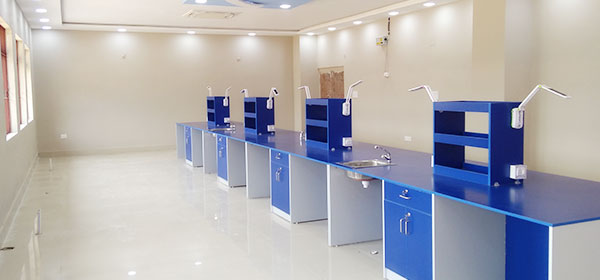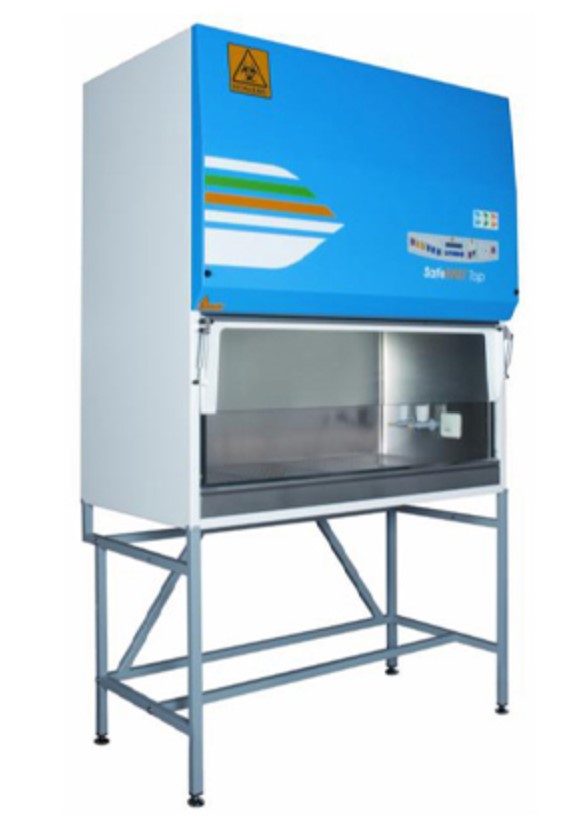Introduction to lab interior design

The Crucial Role of Laboratory Interiors in Scientific Advancement

In the realm of scientific exploration, laboratories serve as the bedrock of innovation, where groundbreaking discoveries are made, and technological advancements are nurtured. The pursuit of knowledge and the quest for solutions to complex challenges hinge upon the meticulous design and functionality of these specialized spaces. While the focus often centers on the sophisticated equipment and cutting-edge technologies employed within laboratories, the significance of **Laboratory Interiors** as a critical component in fostering a conducive research environment is often overlooked.
The design of a laboratory goes beyond aesthetics; it plays a pivotal role in shaping the efficiency, safety, and overall success of scientific endeavors. A well-designed laboratory interior can enhance workflow, optimize resource utilization, and promote collaboration among researchers. Conversely, a poorly planned space can lead to inefficiencies, safety hazards, and ultimately, hinder scientific progress.
The importance of **Laboratory Interiors** extends beyond the immediate needs of researchers. It also has a profound impact on the overall reputation and success of scientific institutions. A modern, well-maintained laboratory space reflects the commitment of an organization to scientific excellence and innovation. It can attract top talent, foster partnerships, and enhance the institution's standing within the scientific community.
In today's rapidly evolving scientific landscape, where competition for funding and resources is fierce, the need for optimized laboratory environments has become paramount. Institutions are increasingly recognizing the value of investing in **Laboratory Interiors** that not only meet the functional requirements of research but also create a stimulating and inspiring environment for scientific exploration.
This article delves into the multifaceted aspects of **Laboratory Interiors**, exploring the key considerations that contribute to the creation of a high-performing laboratory space. We will examine the impact of design elements on workflow, safety, collaboration, and overall research productivity. By understanding the principles of effective laboratory design, institutions can create environments that empower researchers to achieve their full potential and drive scientific progress.
The Importance of Laboratory Interior Design

In the realm of scientific research and development, laboratories serve as the bedrock of innovation, where groundbreaking discoveries are made and cutting-edge technologies are developed. The design of a laboratory plays a pivotal role in shaping its functionality, efficiency, and overall success. A well-designed laboratory interior not only enhances the aesthetics but also optimizes workflow, promotes safety, and fosters a conducive environment for scientific exploration. This article delves into the multifaceted aspects of laboratory interior design, exploring its significance, key considerations, and best practices.
The Evolving Landscape of Laboratory Design
The landscape of laboratory design has undergone a dramatic transformation in recent years, driven by advancements in technology, evolving research methodologies, and a growing emphasis on sustainability. Traditional laboratory spaces, often characterized by rigid layouts and limited flexibility, are giving way to more dynamic and adaptable environments. Modern laboratory interiors are designed to accommodate a wide range of scientific disciplines, from life sciences and chemistry to materials science and engineering. The focus is on creating spaces that are not only functional but also inspiring, fostering collaboration, and promoting innovation.
The Crucial Role of Functionality in Laboratory Design
Functionality is paramount in laboratory design, as it directly impacts the efficiency and effectiveness of scientific research. A well-designed laboratory interior should facilitate smooth workflow, minimize bottlenecks, and optimize the use of space. This involves careful consideration of factors such as:
- Layout and Circulation: The layout of a laboratory should be designed to facilitate efficient movement of personnel and equipment, minimizing the risk of collisions and maximizing accessibility to critical areas. Clear pathways, designated work zones, and ample storage space are essential for a functional laboratory.
- Ergonomics: The design of laboratory furniture and equipment should prioritize ergonomics, ensuring the comfort and well-being of researchers. Adjustable workstations, ergonomic chairs, and proper lighting can reduce fatigue and enhance productivity.
- Services and Utilities: Laboratories require a comprehensive network of services and utilities, including electrical power, gas, water, and ventilation systems. The design should ensure that these services are readily available and meet the specific requirements of the research being conducted.
- Safety and Security: Safety is of paramount importance in any laboratory setting. The design should incorporate features that minimize the risk of accidents, such as fire suppression systems, emergency exits, and proper ventilation. Security measures, such as access control systems and surveillance cameras, should also be implemented to protect sensitive equipment and research data.
The Importance of Aesthetics in Laboratory Design
While functionality is essential, aesthetics should not be overlooked in laboratory design. A visually appealing and inspiring environment can enhance the overall experience of researchers, fostering creativity and motivation. The use of color, lighting, and materials can significantly impact the mood and atmosphere of a laboratory. Here are some key considerations for creating an aesthetically pleasing laboratory interior:
- Color Psychology: The use of color can have a profound impact on mood and productivity. Cool colors, such as blue and green, are often associated with calmness and focus, while warm colors, such as red and yellow, can stimulate energy and creativity. The choice of colors should be carefully considered to create an environment that is conducive to the specific research activities being conducted.
- Lighting: Proper lighting is crucial for both functionality and aesthetics. Natural light should be maximized whenever possible, as it has been shown to improve mood and productivity. Artificial lighting should be carefully planned to provide adequate illumination for all tasks, while minimizing glare and shadows.
- Materials: The choice of materials for laboratory interiors should be both functional and aesthetically pleasing. Durable and easy-to-clean materials, such as stainless steel, epoxy resin, and ceramic tile, are commonly used in laboratory settings. The use of natural materials, such as wood and stone, can add warmth and texture to the space.
The Role of Technology in Laboratory Design
Technology is playing an increasingly important role in laboratory design, enabling researchers to conduct experiments more efficiently and effectively. The integration of technology into laboratory interiors can enhance data collection, analysis, and visualization, as well as improve communication and collaboration. Some key technological advancements that are transforming laboratory design include:
- Laboratory Information Management Systems (LIMS): LIMS are software applications that manage laboratory data, samples, and workflows. They streamline processes, improve data accuracy, and enhance collaboration among researchers.
- Automated Equipment: Automated equipment, such as robotic arms and liquid handling systems, can perform repetitive tasks more efficiently and accurately than manual methods. This frees up researchers to focus on more complex and creative aspects of their work.
- Virtual Reality (VR) and Augmented Reality (AR): VR and AR technologies are being used to create immersive and interactive laboratory environments. This allows researchers to visualize complex data, simulate experiments, and train on new procedures in a safe and controlled environment.
Sustainability in Laboratory Design
Sustainability is becoming an increasingly important consideration in laboratory design. Laboratories consume significant amounts of energy and resources, and it is essential to minimize their environmental impact. Sustainable laboratory design principles focus on reducing energy consumption, minimizing waste, and promoting the use of eco-friendly materials. Some key strategies for achieving sustainability in laboratory design include:
- Energy Efficiency: Implementing energy-efficient lighting, HVAC systems, and equipment can significantly reduce energy consumption. The use of renewable energy sources, such as solar panels, can further enhance sustainability.
- Water Conservation: Water conservation measures, such as low-flow fixtures and water-efficient equipment, can reduce water consumption. The use of rainwater harvesting systems can also contribute to water conservation efforts.
- Waste Reduction: Implementing waste reduction strategies, such as recycling and composting, can minimize the amount of waste generated by laboratories. The use of reusable and recyclable materials can further reduce waste.
The Importance of Collaboration in Laboratory Design
Collaboration is essential for successful laboratory design. The design process should involve input from all stakeholders, including researchers, technicians, engineers, and architects. This ensures that the final design meets the specific needs of the laboratory and its users. Effective communication and collaboration among stakeholders are crucial for achieving a successful outcome.
Conclusion
Laboratory interior design is a multifaceted discipline that requires careful consideration of functionality, aesthetics, technology, and sustainability. A well-designed laboratory interior can enhance efficiency, promote safety, foster collaboration, and inspire innovation. By embracing the principles outlined in this article, laboratories can create environments that are both functional and inspiring, supporting the pursuit of scientific discovery and technological advancement.
Optimizing Your Laboratory Environment: A Holistic Approach
The journey towards a well-designed laboratory is not merely about aesthetics; it's about creating a space that fosters efficiency, safety, and scientific excellence. By understanding the principles of laboratory interior design, you can transform your workspace into a dynamic hub of innovation. This journey requires a holistic approach, encompassing the following key aspects:
1. Functionality and Workflow: The Foundation of a Successful Lab
The heart of any laboratory lies in its functionality. A well-designed lab prioritizes workflow, ensuring that every step, from sample preparation to analysis, is seamless and efficient. This involves:
- Strategic Space Planning: Optimizing the layout of equipment, workstations, and storage areas to minimize movement and maximize productivity. This includes considering the flow of people and materials, ensuring clear pathways and avoiding bottlenecks.
- Ergonomic Design: Prioritizing the comfort and well-being of lab personnel. This involves selecting furniture and equipment that promote good posture, reduce strain, and enhance overall comfort. Ergonomics not only improves productivity but also minimizes the risk of injuries.
- Integrated Technology: Seamlessly integrating technology into the lab environment. This includes incorporating advanced equipment, automation systems, and digital platforms to streamline processes, enhance data management, and facilitate collaboration.
2. Safety and Compliance: A Paramount Concern
Safety is paramount in any laboratory setting. A well-designed lab prioritizes safety by:
- Hazard Mitigation: Implementing measures to minimize the risk of accidents and exposure to hazardous materials. This includes proper ventilation systems, emergency showers and eyewash stations, and clearly marked safety zones.
- Compliance with Regulations: Adhering to industry standards and regulatory guidelines. This involves ensuring that the lab design meets all relevant safety and environmental regulations, including those related to fire safety, chemical storage, and waste disposal.
- Clear Signage and Labeling: Utilizing clear and concise signage to identify hazardous areas, emergency exits, and safety protocols. This ensures that all personnel are aware of potential risks and know how to respond in case of an emergency.
3. Aesthetics and Inspiration: Creating a Positive Work Environment
While functionality and safety are paramount, a well-designed lab also considers aesthetics and the overall work environment. This involves:
- Color Psychology: Utilizing color schemes that promote focus, clarity, and a sense of calm. This can involve incorporating calming blues and greens for areas requiring concentration, while brighter colors can be used in common areas to foster collaboration.
- Natural Light and Ventilation: Maximizing natural light and ventilation to create a more pleasant and stimulating work environment. This can involve strategically placing windows, incorporating skylights, and ensuring adequate airflow.
- Sustainable Design: Embracing sustainable practices in the design and construction of the lab. This includes using eco-friendly materials, minimizing energy consumption, and implementing waste reduction strategies.
4. IT Tech: Your Partner in Laboratory Excellence
IT Tech understands the critical role that a well-designed laboratory plays in scientific success. We offer a comprehensive range of products and services to support your lab's needs, including:
- Lab Consumables: A wide selection of high-quality consumables, including glassware, plasticware, reagents, and other essential supplies, ensuring that your lab is equipped with the necessary tools for success.
- Lab Equipment: State-of-the-art equipment, from basic laboratory instruments to advanced analytical systems, providing you with the tools you need to conduct your research and achieve your scientific goals.
- Laboratory Design and Consultation: Expert guidance and support in designing and optimizing your laboratory space, ensuring that it meets your specific needs and fosters a productive and safe work environment.
We are committed to providing you with the best possible solutions to enhance your laboratory experience. Contact IT Tech today to discuss your specific needs and explore how we can help you create a laboratory that is both functional and inspiring.
Contact IT Tech:
To learn more about our products and services, or to request a consultation, please visit our website or contact us directly. We are here to help you achieve your scientific goals.
Website: https://www.ittech.com.sg/contact
Email: sales@ittech.com.sg
Phone :+ 65 68970626
Let IT Tech be your partner in creating a laboratory that empowers you to achieve scientific excellence.
Products You may Like
Check out other IT- Tech product that suit your taste
Subscribe to our newsletter
Stay updated with IT-Tech Insights
Related posts
Check out other IT- Tech Scientific Resources

Comparing lab benchtop and flooring materials
Selecting the appropriate lab benchtop and flooring materials is essential for creating a safe, durable, and functional research space. This article explores the characteristics of common materials used in laboratories, including their resistance to chemicals, heat, and abrasion. We delve into the pros and cons of each material, considering factors like cost, maintenance, and suitability for specific applications. By understanding the differences between various options, you can make informed decisions to optimize your laboratory's performance and longevity.

Selecting lab water purification equipment
Selecting the right lab water purification equipment is crucial for accurate research and reliable results. This article guides you through the decision-making process, considering factors such as the type of water purity required, the volume of water needed, and the budget. We discuss different types of purification technologies, including reverse osmosis, distillation, and ion exchange, and help you determine the best fit for your Public Health Engineering lab. By understanding the key considerations and available options, you can make an informed decision and ensure your lab has access to high-quality water for all your experiments.

BICASA LABORATORY FURNITURE: DESIGN FOR TODAY AND TOMORROW
Equipped benches, partition systems, supply beams, fume cupboards and furnishing complements set up the integrated system of BICASA and IT TECH collection, designed to offer a complete solution for all laboratory needs.













































































